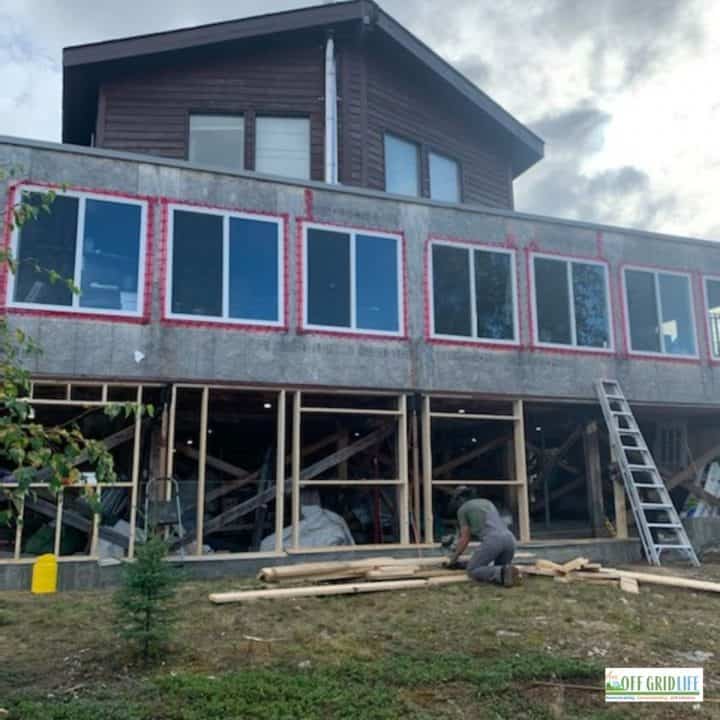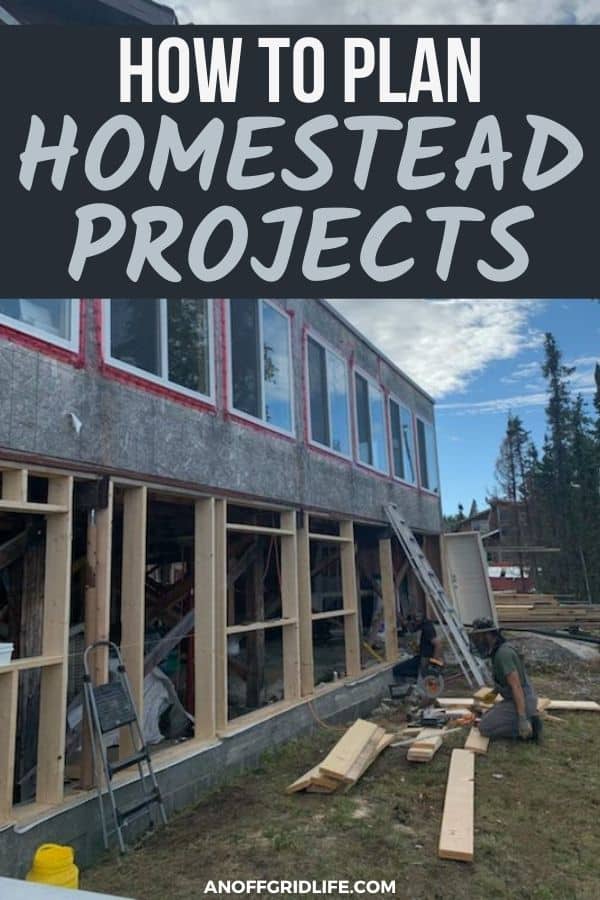Homesteading Lesson Number One: You'll always have homestead projects to complete.
No matter the season or the size of your property, or whether you're an old-time homesteader or getting ready to start homesteading today, projects are always waiting for you. And if you're like most of us, your homesteading project list will probably be a whole lot bigger than your homestead budget.
As a result, you may feel discouraged and overwhelmed. Don't. You simply need a plan of attack. And a method to organize your many DIY homestead projects and ideas.
So how do you know which ones to tackle first?
Use these tips to help prioritize your homestead projects, renovations, and repairs. Then use the free Homestead Projects Printable Pack (scroll down to the bottom of the post for it) to get your own homestead projects organized.
How to Plan Homestead Projects

Estimated reading time: 8 minutes
1.Brainstorm a Homestead Projects List
What needs to get done on your homestead? When I look around our place, it seems like every corner includes something that requires fixing, replacing, or building.
We must install a new wood stove, choose new generators and a solar system, and build a pallet fence around the garden.
I feel overwhelmed by all the work that needs to be done. And it's a pretty short walk from "overwhelmed" to "discouraged."
Making a list helps me feel like I'm taking action.
So the first thing to do is to make a list of everything you want to do. Grab a pen and a pad of paper (or your tablet), and record each thing.
And by the way, if you're a homesteading and homeschooling family, this is a great educational hands-on activity!
Give each item a letter, starting with "A". Don't worry about how big or small each thing is.
The idea is to capture all the homesteading projects you'd like to complete. (If you end up with more than 26 then just start again with AA, BB, etc.)
2. Room-By-Room, Building-By-Building, Acre-By-Acre

Brainstorming your homesteading repairs, renovations, or projects list may seem like a free-for-all because you're just writing down whatever pops into your mind. So make it easier to tackle the next steps.
Start your brainstorming list by focusing on one area of your home or property.
Begin in the house. Stand on the front porch, and start listing. For example, maybe you need to repair the porch steps.
Or caulk your homestead kitchen windows to save money on heating costs. Or maybe you really want to paint the front door red.
Write it all down. And number each item - 1, 2, 3...etc.
Next, move into the front hall and do the same. Go through each room on the main floor, the upper floor, the attic, and the basement.
And then move outdoors. Carry on through any outbuildings, barns, storage sheds, and garages.
Go through your garden areas, root cellars, compost heaps, chicken coops, rabbit hutches, barns, etc.
Jot down everything that needs work. And also the projects you'd like to start, like learning how to build a cinder block garden.
Your list might take several pages. After all, homesteading is a long-term commitment. And remember: you don't have to do all the homesteading projects today. Or even this year.
3. Set a Homesteading Budget

Chances are, if you're the kind of person who chooses to homestead, you have a DIY approach to life. And financial self-sufficiency appeals to you.
You're interested in honing your homesteading skills. And that's a good thing because you'll save money on labor when you do any repairs, builds, or projects yourself.
Although you may homestead in pursuit of a simple, more self-reliant lifestyle, homesteading can still be expensive. And even when you're doing it yourself, funding your homesteading projects costs money.
While you may find homestead hacks to save money, as Jill Winger of The Prairie Homestead discovered, cutting costs by using cheaper building materials ends up being more expensive in the long term.
Experts say homeowners of any property (condos, city homes, etc.) should set aside between 1 and 3 percent of a home's value annually for home maintenance costs. Yet homesteading, especially when starting out, often includes more expensive startup costs.
This is particularly true if you homestead off the grid.
Prepare for the fact that you may have to dip into your savings or borrow money to launch your homesteading dreams and move off the grid.
Ease Into Budgeting and Saving for Homestead Repairs and Projects
Start by planning to spend at least 1 percent of your home's value on homestead repairs annually. Divide this amount by 12, then add it to your monthly household budget.
So if your homestead has an estimated value of $200,000, plan to spend at least $2,000 the first year. Then add $166.66 for homestead project savings to your monthly budget. Then adjust this amount upwards as you can.
Related: Off Grid Costs: 5 Expenses We Didn't Expect
4. Identify Urgent Homesteading Repairs or Renovations
Now it's time to go back to your brainstorming list and assess each item. Referring to your list from Step #2, pick out the urgent homestead projects and repairs and mark them with an asterisk or star.
It sounds easy, but how do you identify an urgent homesteading project?
First, an urgent homestead project involves a repair that fixes a safety issue that could hurt you, your kids, guests, or your animals.
For example, our wraparound back porch has several rotten bits that needed fixing this year. (Update: we fixed them. The more rotten board we removed, the more we found.)
Secondly, an urgent homesteading project is one that if delayed by even a few days, could lead to a more expensive homestead investment. Like a leaking roof, an electrical issue, or anything that impacts the structural integrity of any buildings on the property.
Another sign of an urgent project is something that needs to get done in order to help provide homesteading income. That might mean building a new chicken coop, repairing a barn or fence, or investing in a backup generator.
Once you've identified the most urgent projects, note the ones that you'd like to complete next. Think of these as the ones that would be nice to finish but don't have to get completed immediately.
For example, maybe you've been dreaming of expanding your homestead kitchen or pantry. Building a chicken coop. Or perhaps finally getting that greenhouse you always wanted.
Think of the project that will inspire you and remind you why you wanted to homestead in the first place. Around our place, these are things like repainting our kitchen cupboards and ceilings.
Choose one of these less-urgent projects to complete. Look for one that's inexpensive and fun. Maybe painting a front door, or planting a flower bed.
5. How Much Will your Homesteading Projects Cost?
While you may be eager to jump into your DIY homesteading projects, research costs first. Look at local flyers or visit stores or online sites to find the costs of the parts and supplies you'll need.
If you're going to use additional labor, call your local service people for rates.
Tip: We've often found brand new or gently used parts and supplies for our DIY projects online. Check your local buy and sell online ads, and also Facebook groups.
After you've estimated your costs, add 10% for overages.
Once you start your DIY project, you never know what you might find. And unexpected costs are all too common when it comes to renovations and repairs on the homestead.
Read More: How Much Does it Cost to Move Off The Grid?
6. Compare Urgent Homestead Projects And Your Budget
The final step in prioritizing your homestead repairs is to compare your homestead project savings to the cost of your most urgent homestead projects.
Do you have enough saved to cover the urgent renovations? If not, review your household budget. Look for ways to cut costs.
If you don't have enough money saved to finish the work, you have five options:
- Cut your costs immediately to save money for your project.
- Look for items to sell online immediately to get the cash you need now.
- Use unsecured credit to finance the project with your credit card or credit line.
- Borrow against your homestead with a mortgage refinance or a home equity line of credit.
- Trade work or barter with another homesteader for labor and supplies to complete the project.
Homesteading repairs and projects are part and parcel of a homesteading lifestyle. And although you may struggle to prioritize your projects at first, it gets easier as time passes.
You might also like...
Like this post? Save it, share it, and read it!


